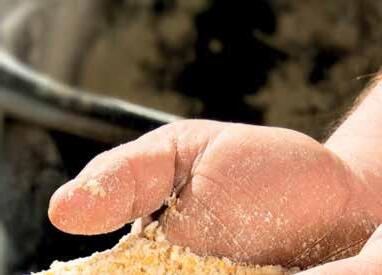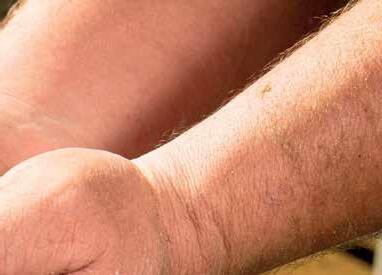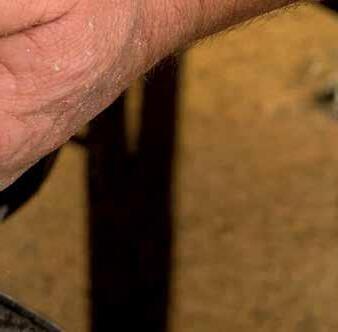

YOUNG FARMER’S CHARITY ROLE
FUTUREFOCUSSED LEADERS
Embrace board roles
Page 8
PAGE 5
FAMILY LEGACY
Strong role model
Page 10
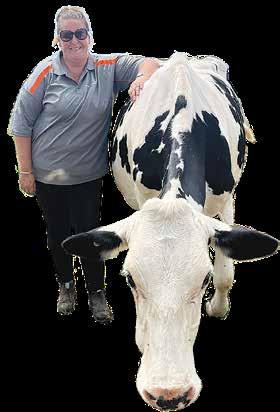




It makes a lot of cents.
Trusted by farmers for effective worm control with NIL MILK withholding periods and improved R.O.I
Studies in NZ dairy cows have shown the potent effects of EPRINEX® on parasites resulted in more daily milk, more milk protein and more milk solids.1,2



Time to end ‘pricey, pointless planning’
SUDESH KISSUN sudeshk@ruralnews.co.nz
IN A major win for farmers, the Government has directed regional councils to halt all work on plans and regional policy statement reviews under the Resource Management Act (RMA).
Minister for RMA Reform Chris Bishop says rather than let “these pricey, pointless planning and policy” processes play out, the Government will be giving councils clarity on where to focus their efforts while they await the new planning system.
“The Government will suspend councils’ mandatory RMA requirements to undertake plan and regional policy statement reviews every ten years, and the requirement to implement national planning standards. We will also extend the restriction on notifying freshwater planning instruments which we put in place last year,” he says.
“The Resource Management Act (RMA) has crippled New Zealand for decades, and the Government’s planning system reforms are well underway to make it easier to get things done in New Zealand,” Bishop says.
“We’ve already made a series of quick and targeted amendments to provide relief to our primary sector and passed the Fast-track Approvals Act to speed up the consenting process for projects with regional or nationally significant benefits.
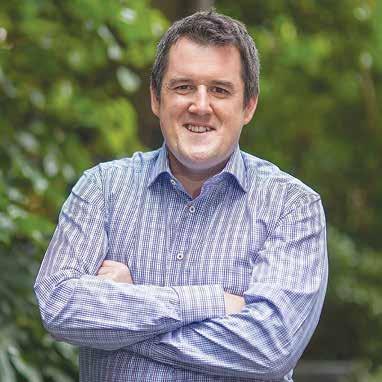
“We’ve also opened consultation on sweeping changes to the regulations that sit under the RMA, and next month our second RMA Amendment Bill is expected to pass into law which will make important changes in the short-term to make it quicker and simpler to consent renewable energy, boost housing supply, and reduce red tape for the primary sector.”
Later this year, the Government will introduce two new Acts to completely replace the RMA – one Act to focus on land-use planning and the second to focus on the natural environment. The new system will provide a framework that makes it
easier to plan and deliver infrastructure as well as protect the environment.
Federated Farmers RMA reform spokesperson Mark Hooper says councils across New Zealand have been continuing to push ahead with new district plans that put farms under restrictive overlays, such as Outstanding Natural Landscapes and Significant Natural Areas.
“This is despite the fact any plan changes may only have a shelf life of months, given the Government intends to pass a new Resource Management Act next year.
“It’s a huge waste of time - and ratepayers’ money.”
Under the Government directive, councils will be required to withdraw plan reviews and changes that have not started hearings as soon as possible and within 90 days of the law coming into effect. Any rules that have immediate legal effect will continue to apply until the plan review or plan change is withdrawn by councils and then those rules will no longer apply.
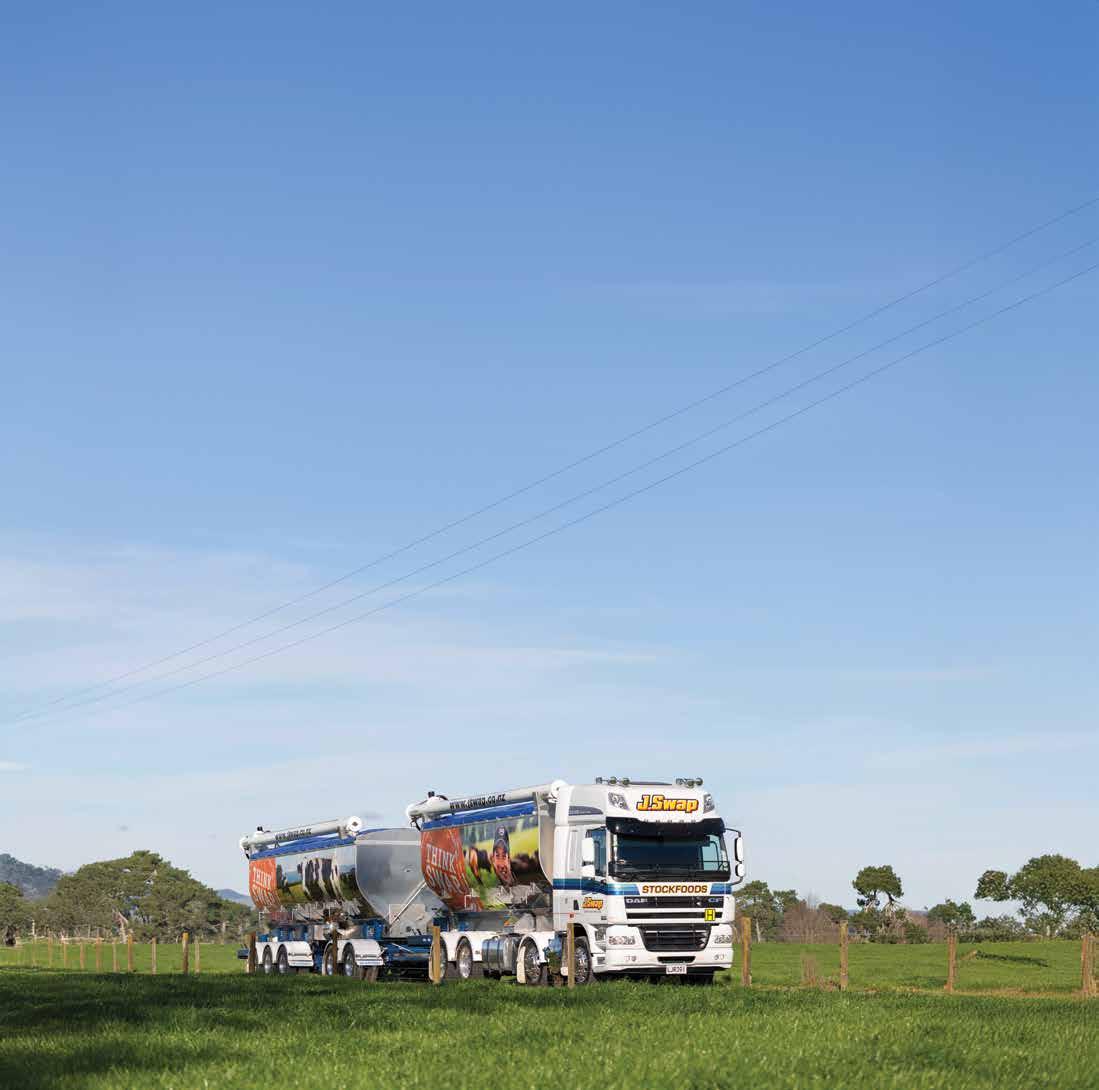
“We will also stop new plan changes and reviews from being notified, except where there is good reason for them to continue,” says Bishop.
“This decision has been made after careful consideration, and a recommendation from an Expert Advisory Group (EAG) that the Government relieve some of the workload of councils in the lead up to the new resource management system.
“The Government’s intention is that stopping plan requirements for councils will enable them to focus on critical work to prepare to transition to the new system.”
Hooper says farmers are welcoming the Government’s decision as it will stop councils from rushing through new restrictive plan changes.
“We trust a new RMA, based on property rights, won’t allow councils to take basic property rights away from farmers in the form of restrictive overlays. Halting plan changes now avoids councils rushing to put in new red tape before a new RMA is in place.”

Good milk makes great cheese. PG.06
Minister for RMA Reform Chris Bishop says the Government will be giving councils clarity on where to focus their efforts while they await the new planning system.
Lactalis edging closer to buying Fonterra business
multinational dairy cooperative FrieslandCampina to bid for Fonterra assets.
THE WORLD’S largest dairy company may be in pole position to acquire Fonterra’s Australian assets.
Lactalis cleared a major hurdle this month when the Australian Competition and Consumer Commission (ACCC) indicated that it would not oppose Lactalis’ proposed acquisition of Fonterra’s consumer, dairy ingredients and food service businesses.
Another Australian dairy processor, Bega Cheese, has also applied for clearance from ACCC to buy Fonterra businesses, being put on sale as part of a divestment of the co-op’s consumer business. Latest media reports from Australia say Bega has formed a consortium with Dutch
The third player making a bid is Japanese food company Meiji Holdings.
However, the green light from ACCC puts Lactalis Australia at the front of the queue.
Lactalis and Fonterra both currently acquire raw milk from dairy farmers in Victoria and Tasmania, as well as processing and supplying a range of dairy products across Australia. The ACCC decision means there are no regulatory hurdles for the acquisition.
“We looked very closely at the transaction as it will combine two of the largest buyers of raw milk in Victoria and lead to some further consolidation in Tasmania,” ACCC deputy chair Mick Keogh says.
“While we acknowl-

edge the concerns raised by some representative bodies, after careful consideration we have determined that the acquisition is unlikely to result in a substantial lessening of competition.”
The ACCC found that across Gippsland, the Murray and Western Victoria, alternative buyers
SUPPLY-SIDE
GLOBAL DAIRY prices have ended a two-month run of losses.
Last week’s Global Dairy Trade (GDT) auction saw the price index rise 1.1% to US$4380/metric tonne. The whole milk powder price rose 1.7% to US$3928/MT.
According to Cristina Alvarado, head of dairy insights at NZX, broader market sentiment may also be influenced by growing supply-side risks.
of raw milk would continue to constrain Lactalis if the acquisition proceeded.
“We found that while the industry in Tasmania is already concentrated, Lactalis has a limited presence and the acquisition would not substantially alter the market dynamics. If the acquisition proceeded, Lacta-
lis would continue to be constrained by Saputo and, to a lesser extent, Mondelez,” Keogh says.
“Because Fonterra and Lactalis have differing end product mixes, they often seek to acquire milk from farmers with different production profiles. Accordingly, we found that they are not likely to be each other’s
closest competitors. This was reflected by analysis which showed very few farmers switched between the two processors.”
The ACCC also concluded that the transaction was unlikely to substantially lessen competition in the wholesale supply of dairy products such as drinking milk, cream, cheese, chilled yellow spreads and dairy ingredients like milk powder.
Fonterra’s portfolio in Australia includes the country’s top butter brand, Western Star and popular cheese brands - Perfect Italiano, Bega Cheese, and Mainland. Lactalis Australia has Paul brands of fresh milk, yoghurt and cream plus several top selling brands of flavoured milk and cheese.
The differing production focus of Fonterra
and Lactalis meant that there was limited overlap between the two in the supply of these products.
For longer-life, readily transportable products such as cheese, dairy ingredients and chilled yellow spreads, the ACCC found that retailers and wholesalers would also continue to benefit from import competition.
Fonterra’s Oceania business includes its fresh milk plant in Takanini, South Auckland. I t’s unclear whether Lactalis will move into the NZ market or Fonterra will have to find a separate buyer for its NZ operations.
Lactalis is a privately owned company primarily owned by the Besnier family, through the Belgian holding company BSA International SA.
@dairy_news
facebook.com/dairynews
RISKS LIFT DAIRY PRICES
Europe faces mounting challenges from extreme heat in key production regions and the emergence of cattle diseases, such as Lumpy Skin Disease. On top of this, the US administration’s renewed threat of 30% tariffs on European products, adds another layer of uncertainty to forward supply and trade dynamics, she says.
“With the New Zealand season just beginning and these GDT contracts

aligned to peak spring deliveries, the auction confirmed that solid demand remains in place – particularly in the forward curve – despite current global volatility,” says Alvarado.
She says despite seasonal expectations for a softer result, demand held firm.
The results exceeded market expectations, particularly when compared to implied changes from the
SGX-NZX Dairy Derivatives market. Of the main commodities, only AMF landed near forecast, with a 0.8% increase versus a 0.7% implied gain. Stronger than anticipated demand was led by Southeast Asia/Oceania, which lifted its overall share of GDT purchases by 25% compared to the previous event – accounting for 34% of the total product sold, just shy of North Asia’s 35%.
North Asia remained the top buyer of WMP and butter, while Southeast Asia/Oceania took the lead for SMP, AMF, and cheddar – repeating the same regional buying split seen at the previous event. China’s latest production figures, down 4.1% year-on-year for May, alongside persistently low WMP inventories (down 72% YoY), help explain North Asia’s ongoing demand.
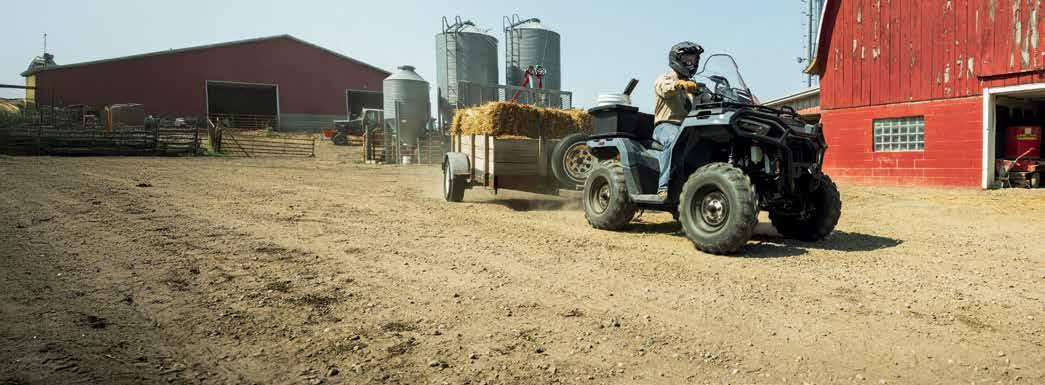
SUDESH KISSUN
Australia’s top butter brand, Western Star is owned by Fonterra.
Farmer-led food charity’s first official ambassador
THE 2024 Ahuwhenua Young Māori Farmer of the Year, Ben Purua has been named farmerbacked charity Meet the Need’s first official ambassador.
Purua is a dairy farm manager, award-winning agricultural leader, and passionate advocate for ‘transformation through farming’.
Based in South Waikato, Ben leads a high-performing System 5 dairy operation centred on innovation, animal welfare, and sustainability. But his influence stretches far beyond the farm gate.
From a turbulent youth to national recognition, Purua’s life is a powerful story of resilience and redemption. Raised in Pukekohe and shaped by adversityincluding time in prison as a teenager - he discovered a passion for farming on a prison farm. That connection to the land sparked a journey of hard work, education, and purpose.
Now the 2024 Ahuwhenua Young Māori Farmer of the Year, Central Plateau Dairy Manager of the Year, and
MEET THE NEED
2024–25 stats:
■ 655,684 mince meals delivered
■ 539,952 milk meals shared
■ 1,195,636 total servings delivered in 12 months
■ 130+ foodbanks and community groups supported monthly
■ 659 unique donors this year, 2,047 total to date
■ 2.9 million meals delivered since launching in 2020
National People & Leadership Award winner, Purua is a sought-after speaker and role model across New Zealand. He’s also the founder of Kamu to Pamu, a rural clothing brand dedicated to mental wellbeing in the agri-sector.
As Meet the Need’s inaugural ambassador, Purua will use his voice, platform, and ‘lived experience’ to champion the charity’s mission, ensuring every New Zealander has access to nutritious
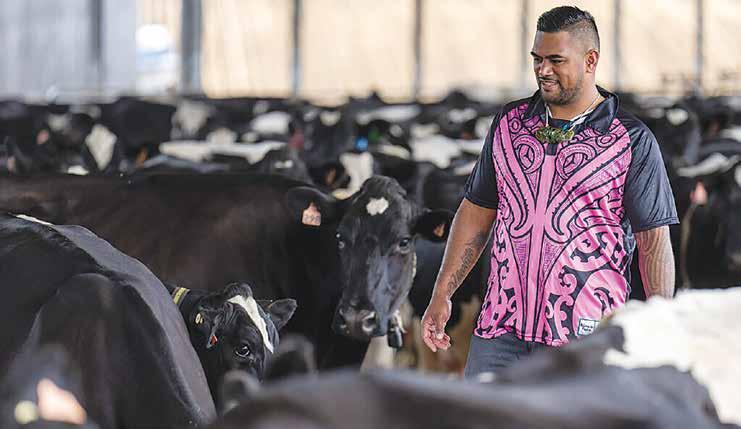
protein, no matter their circumstances.
“I know what it’s like to go without,” says Purua.
“Being able to give back through farmingto use what we grow to feed those doing it tough - is powerful. Meet the Need is real, it’s authentic, and it’s led by farmers. I’m proud to stand with them and help carry the kaupapa forward.”
Zellara Holden, general manager of Meet the Need, says the team couldn’t be more excited to have Purua on board.
“Ben embodies the heart of Meet the Need. His story is one of strength, service, and second chances. He represents the best of our rural communities and a vision of what’s possible when we lift each other up.
“We are thrilled to welcome him as our first ambassador and know he’ll help inspire even more farmers to be part of this collective movement to end food insecurity in Aotearoa.” The appointment comes at a time of significant growth for Meet the Need, which has now delivered over 3 million meals - thanks to the generosity of New Zealand’s
farmers, producers, and partners.
Meet the Need is a farmer-led charity that supplies food to the needy members of the community.
Last month it released its first-ever Impact Report, highlighting the power of communitydriven food support.
Between April 2024 and March 2025, Meet the Need delivered
over 1.19 million mince and milk meals to families across New Zealand — thanks to the generosity of Kiwi farmers, food producers, and partners who share a belief that no one should go hungry in a country that grows so much.
The charity’s three main processing partners are Fonterra, Miraka and meat company Silver Fern Farms.

Your Co-op has built
Your milk. Your time.
Your Co-op.
Farmer Ben Purua says he’s proud to work with Meet the Need.
Good milk makes great cheese
THE BASIS for making great cheese is good milk, says the owner of Banks Peninsula’s Barry’s Bay
Cheese, which was named Champion of Champions Mid-Size, for its traditional Aged Gouda, at this year’s NZ Champions of Cheese Awards.
“And we source that
with the help of Fonterra from farms around the Motukarara area,” says Daniel Shields.
“So, it’s local fresh milk that comes to us straight from the farm.”
The gouda was pronounced “delightful” by the judges who also noted its “lovely chewy fudgy texture. Pronounced fruit, sweet, umami flavours. Excellent.”
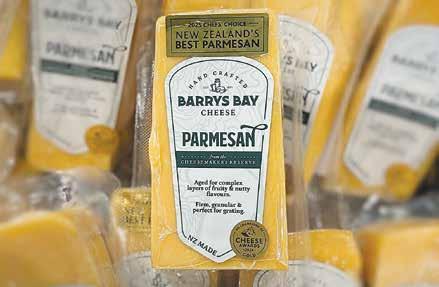

The FSQSNZ (Food Safety Quality Solutions) – sponsored Champion of Champions Mid-Sized was one of four trophies awarded to Barrys Bay.
The winning Gouda also won the AsureQuality Champion Dutch-Style; its Canterbury Red won the Tetra Pak Champion Retail Cheddar Cheese; and a parmesan won the Sabato Chefs’ Choice.
The Barrys Bay factory is a popular landmark and stop-off on the road between Christchurch and Akaroa, nestled at the very northern end of Akaroa harbour.
Founded in 1895, it is the only survivor of several small dairy cooperatives that once flourished on Banks Peninsula.
Shields worked as its distributor for 5 years before buying the company with his wife Amy in 2017, in time to celebrate its 125th anniversary in 2020.
“We’ve got a history of performing well but this was an exceptional year,” said Shields. “To win the Champion of Champions for the small to mediumsized cheese makers was very pleasing.”
The company uses cow’s milk almost exclusively, all sourced locally, and makes just one sheep’s milk pecorino.
With 15 staff, Shields gave credit to his loyal team of cheese makers, some of whom have been with Barry’s Bay for nearly 20 years, and who work consistently to improve the product all the time.
However, the head cheesemaker, Pete Corbitt, lives at Little River which was among the areas of Canterbury hardest hit by the big storm that coincided with the cheese awards event in Hamilton. He was unable to get out to attend the event.
Shields says the company makes about 24 different “amazing cheeses from fantastic New Zealand milk” but it is getting harder to sell it to New Zealanders because of the restrictions imposed by New Zealand’s supermarket duopoly.
While Shields says this reporter’s local supermarket – Fresh Choice in Merivale, Christchurch –has been a very loyal supporter, generally what’s happening is that the range of cheeses they can supply to supermarkets is being reduced all the time.
“They want a higher margin, they want lower pricing, and they want fewer different types of cheese in the categories so that it’s easier for them to manage with lower staff levels.
“When 85% of grocery purchases are made through major supermarkets, it’s hard to break that mould but we’re always looking and we know from consumers that they are looking for alternatives as well because we service them directly through food shows and so on.”

Barry’s Bay parmesan cheese won the Sabato Chefs’ Choice award.
NIGEL MALTHUS
Motueka monstered by dual flooding events
“THE WORST of the worst” is how Richard Kempthorne, the chair of the Nelson Tasman Rural Support Trust, describes the cumulative effects of the two storms that have wreaked havoc across the top of the South Island. He told Dairy News that farms - dairy and sheep and beef, orchards and lifestyle blocksalong the Motueka River have been dramatically affected with land washed away, debris and silt deposited on land and huge damage done to infrastructure.
“I have never seen it as bad as this and it’s not only damage to properties; infrastructure, namely roads, have been badly damaged. At one stage there were 30 roads, including the state highway closed across the region.
“Re-instating basic infrastructure will be in the multi millions, not the hundreds of the thousands,” he says.
Richard Kempthorne says with roads closed, children were unable to get to school and people could not get to work.
“I have never seen it as bad as this and it’s not only damage to properties; infrastructure, namely roads, have been badly damaged.”
He says the problem was compounded by basic things such as power and internet outages and damage to water supply facilities.
“For some people the recovery will take many months – for other’s, years,” he says.
For many people the first flooding event was a huge disaster and in the 10 or so days between the two storms, they had repaired some of the damage, only to find this undone by the second storm.
There are also reports that the most recent event brought down more silt and this is a huge problem for both livestock farmers and horticulturalists. Forest owners have also been hit with trees flattened by
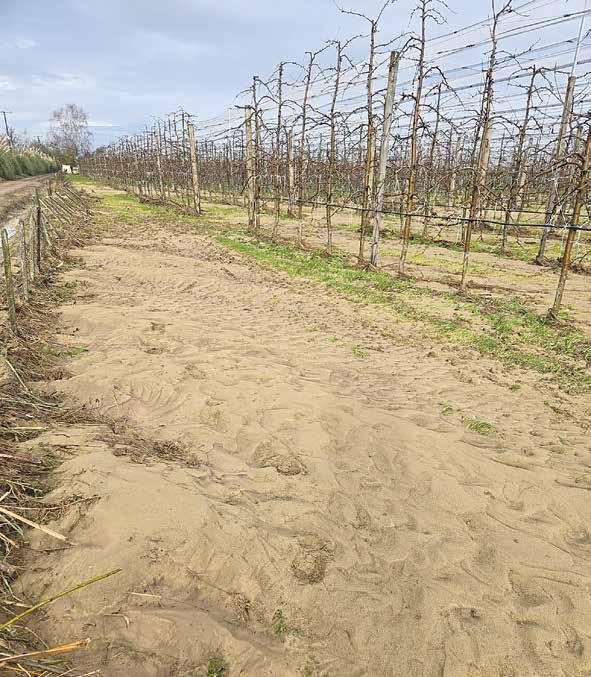
high winds.
Kempthorne says, for livestock farmers, the

answer may be to wait until the silt dries out and if it’s not too deep,
sow it in grass and potentially mix it in with existing soil. For orchardists,
from
may help save trees that have
flooded or covered in silt.
As the heartbreaking task of cleaning up continues, the Rural Support Trust is surveying the farmers and growers to see what help they need from voluntary groups such as Enhanced Task Force Green to help clean up debris and also from Task Force Kiwi.
Kempthorne says RST has set up an 0800 number – 0800 787254, that people wishing to join Task Force Green can call and register to help.
Kempthorne says government Ministers and officials have visited the region to get a first-hand look at the devastation. He says at this stage it’s too early to get an accurate estimate of the cost to repair the damage the floods and storms have caused, but they realise the event is putting huge stress on people and they want to have services in place to look after their mental wellbeing.
He says the RST is now pulling together a whole lot of information to provide to government a very accurate assessment of the financial help that will be required to get the region back on its feet.

Hoof Up From day one
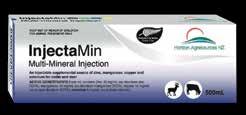

the lessons learned
Cyclone Gabrielle
Orchards and farms in the Nelson and Tasman regions were inundated by floods this month.
Farmers urged to embrace board roles
FARMING IS changing fast, and future-focused leaders are needed in New Zealand’s boardrooms.
That’s according to Ravensdown director Kate Faulks, who says there are many astute farmers out there who already have what it takes to be good board directors.
“They’re constantly scanning, solving problems, exploring opportunities, looking for better efficiency and they’re often thinking long-term and they’re doing this day to day in their businesses so whether they know or not, those things all translate really well to the boardroom,” Faulks told Rural News
Elected to the Ravensdown board in September
2024, Faulks has a unique perspective on governance. She holds a Bachelor of Engineering with Honors in Chemical & Process and a Master of Business Administration and since 2018, Faulks and her husband Adam have been farming in North Otago, rearing and finishing 500 dairy-beef and grazing 1400 dairy stock.
“My background in engineering operations laid a good foundation for governance. Both require the ability to understand complex problems and then explore multiple solutions so it sort of trained me to be by default a systems-thinker and always thinking bigger picture but then when we began farming in 2018, I began really interested in the role of cooperatives, not just because of their role in agriculture
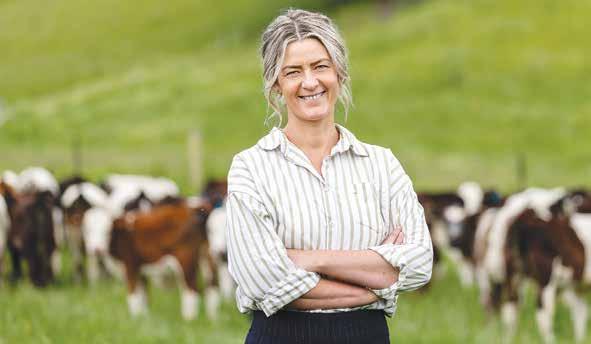
but how they influence the broader economy,” she says.
She says it was agriculture’s role in New Zealand’s economy that motivated her to get involved in governance.
“I think governance really offers you the
opportunity to contribute to those decisions that don’t just effect a business, but they effect entire communities, stakeholders, and future generations effectively.
“It really relates quite closely to farming because I think very
much about stewardship in terms of the role of a director and I see it more as being a custodian of the company, similar to how farmers are custodians of the land and we’re making decisions now that will position us better for the future.”
Faulks says that while strategic thinking is an important trait for those wanting to be on boards, she values things like clarity.
“I think governance is just as much about the emotional intelligence… I think a good director
stays curious, they have the courage to ask both the tough questions and also the really simple questions are just as important.
“I think it’s equally as important to know what governance is not. It’s not running the business,” she says. “We have an excellent leadership team that’s actually taking care of that.”
Faulks says farmers looking to join a board should start locally.
“Start where you are, whether it’s a local board, a catchment group or a local trust. Every experience builds your skillset and sharpens your thinking.”
In 2025, Ravensdown shareholders will have the opportunity to nominate and elect two directors to the company’s board – one in the North Island and one in the South Island.

JESSICA MARSHALL
jessica@ruralnews.co.nz
Ravensdown director Kate Faulks says there are many astute farmers who already have what it takes to be good board directors.
Urgent call for alternative grass grub weapon
SUDESH KISSUN sudeshk@ruralnews.co.nz
AN INSECTICIDE widely used to control pests in pasture and grain crops will be banned by the end of next year, but farmers warn of a looming gap in treatments to fight native grass grub, which costs the agricultural sector hundreds of millions of dollars each year.
The Environmental Protection Authority (EPA) is banning chlorpyrifos, after reassessing the chemical. The ban will come into effect progressively during an 18-month phase-out period.
Chlorpyrifos is a broad-spectrum organophosphate insecticide used to control pests in pasture and grain crops such as wheat and for biosecurity treatment of pests.
The chemical is banned in the European Union and Canada, and its use is heavily restricted in Australia. It is in the process of being phased out internationally via the Stockholm Convention, of which New Zealand is a signatory.
As part of the reassessment, the EPA considered new information, called for submissions, and held a public hearing. A decision-making committee found that risks

to people and the environment from using the insecticide outweighed the benefits.
“Operators spraying the insecticide and bystanders are most at risk from immediate and long-term health issues,” says Dr Shaun Presow, hazardous substances reassessments manager.
New evidence shows that even full personal and respiratory protective equipment doesn’t fully mitigate the health risks.
“The health risks for children exposed to chlorpyrifos in particular are concerning, which is why we have put in place an immediate ban
NEW TOOLS IN THE PIPELINE
FEDERATED FARMERS understands AgResearch and agrichemical companies are well underway with developing a new tool for combating grass grub.
“We’d really like to see them accelerate that development work. It would be disastrous for food production and our agricultural exports if our farmers are left high and dry for any period without an effective control method,” David Birkett says.
A 2018 study said native scarab grass grub causes losses of up to $380 million on dairy farms and $205 million on sheep and beef farmers every yearand that was with access to chlorpyrifos.
Birkett says the EPA also needs to play its role swiftly.
“Federated Farmers has been critical of the EPA’s failure to get on top of a backlog of assessment applications for agri-chemicals and animal health treat-
ments.
on using the chemical in public places,” says Presow.
“Chlorpyrifos also has harmful effects on plants and animals on land and in waterways.”
However, farmers warn that the ban means there’s a real risk farmers’ arsenal to fight grass grub will soon be empty.
Feds biosecurity spokesperson David Birkett says Costelytra giveni (grass grub) is the biggest agricultural pest by a country mile.
He says it’s a scourge for pasture and lawn, and a risk to horticulture and native plant root systems.
The two most effec-
“We’ve welcomed government announcements on new measures aimed at streamlining assessment processes, particularly in cases where chemicals are already being used safety in other countries.
“But the EPA also needs to adjust its priorities and not focus on assessing generic chemicals that are already available,” Birkett says.
“Their work stream needs to take better account of how far off approvals are for effective replacement products, including biosecurity and pest increase issues, and how much delays would cost the country.
“The new chemicals that offer the greatest economic benefits should get priority in the queue - and I would put any new treatment for grass grub in that category,” Birkett says.

tive chemicals to control the grub - chlorpyrifos and Diazanon - are both being phased out after decisions by the EPA to ban them.
“It’s pleasing that manufacturers have work underway developing new chemicals. We also need the EPA to prioritise and
fast-track their assessment of any new options.” Birkett is pleased that the EPA listened carefully to its submission and decided that, for the agricultural sector, the ban would come at the end of an 18-month phaseout period.
“However, stocks of chlorpyrifos are already very limited and, in the face of bans, manufacturers are taking it out of production.”
The other potent weapon for combating grass grub, Diazanon, will also be banned from 2028.

Chlorpyrifos (above right) is used to control pests in pasture and grain crops.
A lineage of leadership
TAHUNA DAIRY farmer
Annabelle Scherer is hoping to continue the legacy her mother has handed down to her: one that represents strong female role models in the New Zealand dairy industry.
Annabelle, Holstein
Friesian NZ vice president, cites her mum Dyanne Osborne as being a huge inspiration to her as a female not only working, but leading in the dairy industry.
“In addition to being
TALKING COWS
a consultant for World Wide Sires for over 30 years, I can still remember mum helping dad on farm, and being a mum as well,” Annabelle says.
“She has had a huge influence on my role in the industry; one that I hope to demonstrate to my daughter as well. I’m following in mum’s footsteps.”
Annabelle’s parents Dyanne and Wayne founded the Charbelle stud almost 40 years ago, and Annabelle grew up deeply involved in the New Zealand dairy industry, and with a passion
WHILE ANNABELLE is still very active on the farm when needed – particularly over calving and calf rearing –she gets great joy from her role as World Wide Sires consultant for North Waikato/Thames Valley, which she has held since 2019.
“I love my job, because it gives me the freedom to remain on farm when I need to be,” she says. “I love going out to visit other farmers; I can talk cows and breeding all day, every day. I get the best of both worlds.”
Annabelle is also in her second term on the HFNZ Board, an experience she has loved.
“I enjoy being a custodian of the breed,” she says. “I’m still learning all the time, and I relish the knowledge of others on the board. I like bridging the gap for farmers to understand that pedigree Holsteins are not a bad thing!”
As a mother of four to Charlie, Gabrielle, Henry and Archer, Annabelle has plenty to keep herself occupied outside of the farm. In addition to “playing taxi driver”, she coaches her daughter’s top netball team at Morrinsville College.
However, the farm remains central to their family and lifestyle.
“I can’t image bringing them up any differently than on farm,” Annabelle says. “It is a great lifestyle, and we work hard to achieve a good work-life balance. We try to have more time off these days, which sometimes happens; we’re hoping that the more seasonal nature of this farm will help.”
The children are all involved on farm and are involved in HFNZ Black & White Youth activities. Charlie has worked for Annabelle and Stephen and will seek work as a dairy farmer going forward.
“I’m super proud of all of them,” Annabelle says. “I hope I’m instilling some of my values in them.”
Having grown up with strong female role models who were active in the dairy industry, Annabelle is relieved that the male dominated dairy industry of the past is all but gone.
“I think more and more women are taking leadership roles on farm now – and for some, their husbands or partners might even work off farm,” she says. “The landscape is definitely changing. The gap is closing, not only in dairy farming, but the dairy industry as a whole.”
Annabelle and Stephen’s goal is still to own their own farm – a goal they will no doubt achieve due to a strong work ethic and working as a team.
“I’m very lucky to have the support of Stephen – it’s a big deal,” Annabelle says. “Being away for work and HFNZ Board commitments means Stephen keeps the wheels rolling at home while I’m away.”
She says when they first met, Stephen wasn’t overly passionate about pedigree cattle – but he has learned to be over time.
“He has developed a love for it too,” she says. “And all my kids have the bug… how could they not, with a mother like me!”
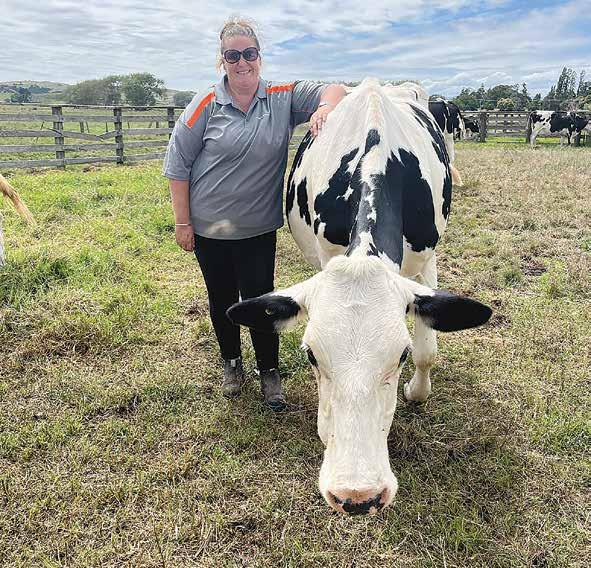
for the Holstein Friesian breed.
“As a young girl I helped my parents show Charbelle animals, and I attended many Holstein Friesian youth camps and had the privilege of being awarded the Arapeta Trophy in 1993,” Annabelle says.
After studying, Annabelle went into the dairy industry and with husband Stephen, they have worked their way up to 50/50 sharemilking 400 cows on 180ha at Tahuna for the Matijasevich family.
The herd is made up of 300 registered Holstein
BREEDING TRAITS
ONE THING that has stayed the same is the traits they are breeding for.
“We want a nice, moderatelysized cow,” Annabelle says. “Fertility remains important, as does udders, feet and legs; they are walking a bit further on this farm.
“At the end of the day, we want to milk moderately-sized cows who put milk in the vat. A functional dairy cow has always been our aim with good, wellattached udders. Longevity is the key for us.”
Annabelle says they have used the World Wide Sires mating programme for many years now.
“It helps with deciding which sires go to which dams, much like TOP cows are assessed for traits and mated to suitable bulls accordingly,” she says.
“We are also moving toward using more sexed semen and beef genetics.”
Annabelle says influential sires in the Charbelle herd include Seagull-Bay Supersire-ET,
Friesian, 70 Jerseys and 50 crossbred cattle in two herds, milked through a 40-aside herringbone shed, and targeting just over 400kgMS/cow as a System 2 farm.
This is the Scherers’ second season on the Tahuna farm, having consolidated two share-
Long-Langs Oman Oman-ET, and more recently Mapel Wood Brewmaster, Duckett-Crush Tatoo-ET, Ensenada Taboo Planet-ET, Sandy-Valley J Pharo-ET, No-Fla Capital, Deleberge Salt and Welcome Silver Griff-ET.
Charbelle is proving its genetic choices are sound as it produces some notable families, including the ‘P’ family.
Starting with Charbelle MWB Prancer S3F EX2 – who was All Breeds Intermediate Champion at the 2020 Stratford A&P Show, All Breeds Intermediate Champion and Holstein Intermediate Champion at the 2020 Waikato A&P Show, and Overall Best Intermediate Udder at the 2021 NZ DairyEvent – the ‘P’ family has made waves on the show circuit in the past five years.
“Prancer was the cow that got us back into showing,” Annabelle says. “We attended NZDE for the first time with three calves, one of which was Prancer, and it escalated from there.”
But it has been Prancer’s
■
milking jobs in Gordonton in the 2023/24 season.
Stephen works on the farm fulltime, and they have one fulltime staff member; Annabelle helps out as needed, around her family responsibilities, HFNZ board schedule and consultancy role with World Wide Sires.
daughter, Charbelle Tatoo Pix EX, that has been the most decorated to date.
Pix was All Breeds Junior Champion at the 2020 Stratford A&P Show, and All Breeds Junior Champion and Holstein Junior Champion at the 2021 NZ DairyEvent.
She was Supreme Intermediate Champion (and Best Intermediate Udder) in 2022 at NZDE, 2022 HFNZ Semex On-Farm Competition Champion 2-yearold, and Champion Junior Cow in the 2022 HFNZ DeLaval All NZ Photo Competition.
She was crowned Supreme Holstein North Island Champion in 2022 and 2023, and Supreme Stratford Show Champion in 2023 and 2024.
In 2024, she won the coveted Beledene Premier Dairy Cow at the Stratford A&P Show and was the 2024 Waikato A&P Show Holstein Friesian Supreme Champion.
She has also won her regional class in the Semex On-Farm com -
■ Stud name: Charbelle
“There has been a lot of changes in the way we farm since we moved to Tahuna,” Annabelle says. “This farm is a lot steeper than our previous farms, and it is a different soil type – we were on peat.
“We no longer feed maize; just a little bit of baleage we make on farm. It is challenging, but we are getting there. Hopefully production will increase next year when the cows are more settled.”
They have also seen big changes in their mating.
“We are no longer split calving: we extended the lactation on our autumn calving cows and now they are all spring calving,” Annabelle says.
petition five years in a row and placed in the top three nationally for four years running.
This year, her daughter, Charbelle Hero Popcorn S3F, was 2025 NZDE Junior Interbreed Reserve Champion and Junior Champion Holstein at NZDE, exhibited by Annabelle’s daughter Gabrielle.
And Pix’s full sister, Charbelle Tatoo Promise, won the Holstein Junior Calf class at 2025 NZDE, pulling out for Junior Champion lineup.
With the quality of cows at hand, it is no wonder that Annabelle and Stephen’s children have become very enthusiastic on the show circuit.
At the 2025 NZDE, all four kids exhibited animals: Gabrielle won the title of Supreme Youth, and Henry won Junior Youth Show Champion Handler. Henry also won Reserve Junior Champion Holstein behind Gabrielle, with Charbelle Pharo Flipper.
“They all did so well,” Annabelle says.
ANNE BOSWELL
Tahuna farmer Annabelle Scherer is hoping to continue the legacy her mother has handed down to her.
Irish insights for Aussies
TWENTY FOUR young farmers from South Australia, Western Australia and Tasmania have returned from a recent study tour of Ireland with practical insights, fresh thinking and an expanded network of peers
Facilitated by Dairy Australia through its Young Dairy Network and supported by DairySA, Western Dairy, DairyTas, SADA Fresh and major sponsor Lely Australia, the tour immersed participants in Ireland’s diverse agricultural landscape.
From dairies and apple orchards to the country’s only purple potato grower, the farmers explored a wide range of enterprises.
Just as valuable as the farm visits were the connections formed within the Australian group and with farmers across Ireland.
South Australian par-
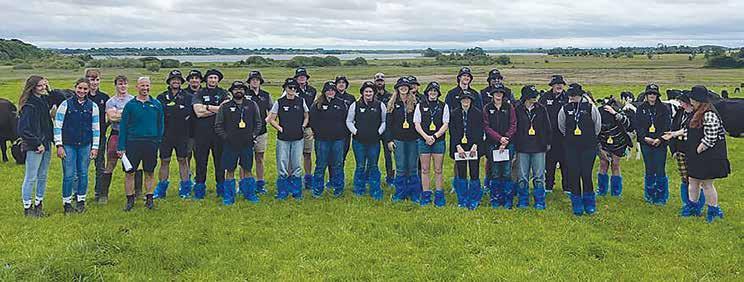
ticipant, Stephanie Lokan, said one of the highlights was speaking with people who shared the same passion.
“It was amazing to meet fellow Australians and also talk to international farmers,” she said.
“I loved seeing the smaller, productive side of Irish dairy and was fascinated by how these farms are small but profitable.
“It’s been very valuable.”
Western Australia participant Fraser Mahaffey agreed.
“I’ve learnt so much in such a short time. I loved seeing the cultural differences between Australia and Ireland and really enjoyed meeting young farmers from across the globe,” he said.
Participants visited a number of different dairy
farms including one run as a partnership – which is rare for Ireland – and a large-scale enterprise that milked 1200 cows across four platforms.
At Moorepark – Teagasc Animal and Grassland Research and Innovation Centre – participants explored topics aligned with their own interests and then came together to share what they’d learned.
A highlight was visiting Gillian O’Sullivan, who spoke at Dairy Australia’s inaugural Grounds for Growth event in March. Gillian runs a once-a-day milking operation on steep country using multispecies pastures.
Dairy Australia South Australia extension advisor Shannon Logan said the group was impressed by the visit to Gillian’s
farm.
“The group loved being able to learn about their unique set-up and were amazed at how they are able to still produce the same amount of milk as cows milking twice a day,” she said.
Another highlight was visiting ex-Olympian and dairy farmer Jamie Costin, who shared insights on grassland management, work-life
balance, and people management.
A unique experience for the group was a trip to a buffalo meat and cheese farm, where they tasted buffalo burgers and cheese. Participants enjoyed patting the milking buffalo, seeing the parlour, cuddling calves, and even milking on the Herringbone system. They toured the farm’s factory, learning how buffalo cheese differs from regular dairy cheese.
Besides farm visits, the group explored historic sites like Blarney and Kilkenny Castles, joined a traditional Celtic dancing night and stopped at the Guinness Storehouse.
The 2025 YDN International Tour, which departed in June, is supported by DairySA, Western Dairy, DairyTas, SADA Fresh and major sponsor Lely Australia.
@dairy_news facebook.com/dairynews



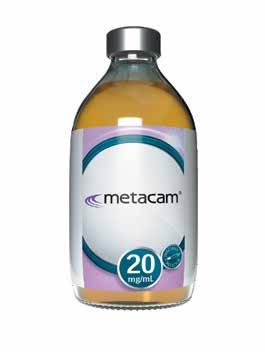
Australian farmers on an Irish dairy farm.
Photo: Shannon Logan, Dairy Australia.
Euro co-ops vote to merge
THE CREATION of Europe’s largest dairy cooperative should be complete by early 2026.
The merged entity will be called Arla Foods and comprises 2200 farmers who are currently part of two co-operatives Arla Foods and DMK Group.
Last month, the decision making bodies of both co-ops voted in favour of a planned merger, which now only has to clear regulatory hurdles.
A joint statement from Arla Foods and DMK says the regulatory approvals are expected in the first quarter of 2026.
The statement says this marks a significant milestone in bringing together two compa-
nies with shared values and complementary strengths, setting the stage for “a new era in European dairy”.
It says the merger unites Arla’s international reach and innovation expertise with DMK Group’s strong and diversified product portfolio and know-how. By supplementing each other’s capabilities, the joint cooperative will “deliver even greater value through a broader range of high-quality dairy products, enhanced product innovation, and resilient market presence”.
Since the announcement of the intended merger, both Arla and DMK Group have held a series of meetings across the companies’ regions, encouraging open debate and giving members the opportunity to share their

views and questions.
Arla chair Jan Toft Nørgaard thanked the co-op farmers for their active participation.
“The approval of the decision-making bodies confirms our shared belief that Arla and DMK Group are stronger together. By combining our complementary strengths, we can secure a more sustainable and innovative dairy sector

for the future, while continuing to deliver value to owners and partners.”
DMK chair Heinz Korte commented on the synergies between the two co-ops.
“At DMK we share the same values as Arla, have the same approach to our work, and a common vision for the future of the dairy industry.
“I am delighted that my fellow farmers
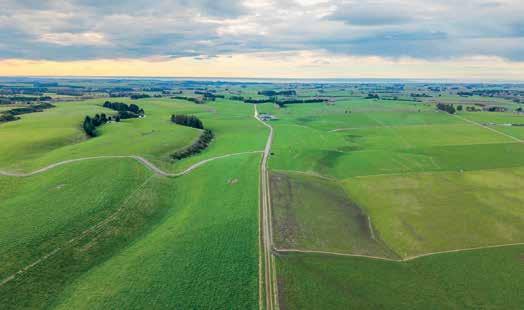
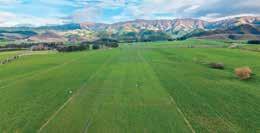
23 Triangle Road, Waimate - “Mariposa Farm”

today have approved the merger and thus support our approach. I would therefore like to thank all members who have shown their belief in the strength of this idea as I firmly believe that this will prove to be a good decision.”
The new entity will be headquartered in Viby J, Denmark. Nørgaard will serve as chair, Arla chief executive Peder Tuborgh
as CEO, and DMK chief executive Ingo Muller will join the Arla executive management team as EVP of post-merger integration.
The partnership between Arla Foods and DMK Group is already proven through successful joint ventures such as ArNoCo, which combines DMK’s strength in cheese production with Arla’s global expertise in ingre-
dients. The two companies say the merger will build on this foundation, driving further advances in dairy technology, sustainable production, and nutritional excellence.
“The approval of our cooperative members is a strong sign. It shows that we live the cooperative idea and believe in joining forces to become even stronger,” Muller says.
Arla Foods is owned by 7600 farmers from Denmark, Sweden, the UK, Germany, Belgium, Luxembourg and the Netherlands. It has annual revenue of 13.8 billion euros and milk volume of 13.7 billion kgMS. DMK, Germany’s largest dairy co-op, is owned by 4600 farmers and has 20 manufacturing sites in Germany and Netherlands.
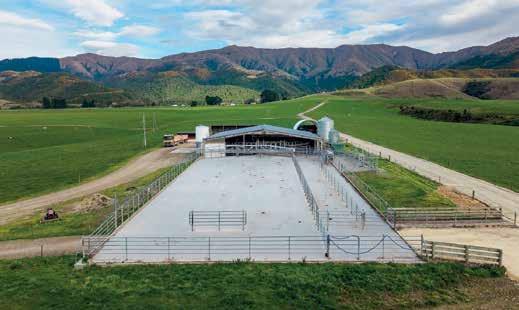

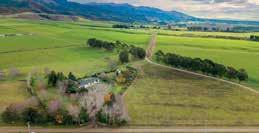
On offer is an outstanding dryland dairy farm totalling 466 hectares (approx.). Located beneath Mt Studholme, 10 minutes out of Waimate in the renowned summer safe area of Hunter. This property was converted in 2009 by the Vendors to a very high standard with excellent infrastructure. It’s on 3 titles and is flat to easy rolling contour with some steeper back sidlings. Soils are predominantly Claremont Silt Loams. Supplying Oceania Dairy, the last six seasons average production totals 330,000 KG/MS from an average peak milk cow numbers of 800. Historically the cows have been wintered on farm and young stock off the property after weaning. Cow number have been increased to 860 wintered for the current season. The farm is well laid out with a central 54 bail rotary shed with cupremovers and auto drafting and a 600 cow rectangle yard. A central loop lane to all paddocks, which all have 2-3 troughs makes management easy. The farm includes a renovated 3 bedroom plus office main homestead, 4 bedroom second home and 2 other staff houses. Improvements and features include a 54 bail rotary shed, 40T wheat silo and crusher, in-shed molasses and PK feed system, covered palm kernel bunker, 7 robotic calf feeders capable of rearing 200 calves, cattle yards, numerous hay sheds and calf sheds, pine plantings on ineffective back faces and halter towers and collars. Retiring Vendors have set the farm up well and will allow a walk in walk out, going concern. A viewing will confirm the quality and opportunity on offer. Call the Sole Agents Ian or Greig Moore for a viewing and the price expectation.
Greig Moore 027 205 9702 greig@redhotrealestate.nz

The new European dairy co-op will be named Arla Foods.
PGW LIFTS EARNINGS GUIDANCE
RURAL TRADER PGG Wrightson has lifted its earning guidance for last financial year on the back of stronger-than-expected performances across several business units.
The listed company says gross operating earnings for year ended June 30, 2025 will now be around $54 million, compared to $51m forecast earlier.
The company says this forecast reflects stronger-than-anticipated performance across several businesses and continued resilience in New Zealand’s agricultural sector.
Chair Garry Moore noted that the agricultural sector has rebounded and built momentum as the financial year has progressed, in contrast to some other parts of the economy.
“Improved farmer confidence, favourable growing conditions, and solid commodity prices have all contributed to a more positive operating environment.”
PGW’s Livestock and Real Estate businesses have delivered a strong turnaround from the previous year.
Dairy and beef prices have remained robust throughout the year, supporting farmgate returns. Lamb prices have held at elevated levels, providing welcome cashflows. Horticulture returns, particularly for kiwifruit and apples, have also been positive, with kiwifruit exports on track for a record year.
Moore says that the 2024 financial year appears to have marked the bottom of the cycle. Improved economic signals, including lower inflation and interest rates, are supporting renewed optimism. Rural real estate enquiries have strengthened, particularly for dairy, beef, sheep and select horticultural properties.
“While the overall outlook is positive, we remain mindful of ongoing challenges in the wool, viticulture, and arable sectors. The performance of our Retail & Water business this financial year has broadly been in line with FY24.
“It is pleasing to be able to report a stronger than anticipated finish to the financial year and lift our guidance expectations. We will have more to say on PGW Group’s performance when we release our audited financial results on 12 August 2025,” says Moore.
NZ to host precision dairy conference
A CONFERENCE providing insights into how precision tools and technologies are shaping the future of the dairy industry will be held in New Zealand in December.
The 4th International Precision Dairy Farming Conference, the first to be hosted by NZ, will bring experts from 24 countries. Delivered by DairyNZ in collaboration with leading research and industry partners, the three-day event arrives at a pivotal moment as sustainable dairy growth becomes a key focus for policymakers and farmers alike.
The conference in Christchurch will feature farm visits showing diverse and innovative precision technologies in action, 120 accepted submissions covering cutting-edge science and practical applications and keynote sessions and farmer panels exploring research, adoption strategies, investment considerations, and system integration.
“DairyNZ is proud to show leadership in applied science, with this conference delivering for both farmers and scientists.
We are bringing together dairy farmers, researchers, rural professionals and agri-tech innovators,” says Nico Lyons, DairyNZ head of science.
“We’re showcasing tools and insights
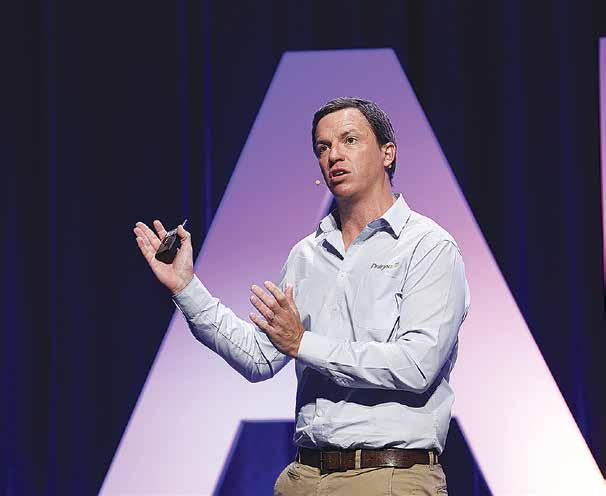
“DairyNZ is proud to show leadership in applied science, with this conference delivering for both farmers and scientists.”
grounded in farm reality, backed by research, and ready to support better decisions on-farm.”
Experts will present on topics such as animal monitoring, sensor technology, and data use, alongside local farmers sharing their experiences with precision approaches

in pasture management, reproduction, animal health, and labour efficiency.
DairyNZ chair Tracy Brown says several leading companies are supporting the conference, including Halter, CowManager, and DeLaval as well as other industry partners.
“By combining worldclass science with practical farmer experience, our goal is to help farmers get the best out of their systems—such as increased productivity, improved animal care, or greater environmental gains,” says Brown.
International keynote speakers include Professor David Rose (Harper Adams University, UK) covering the role of social science for precision dairy research, Assis-
tant Professor Joao Dorea (University of Wisconsin–Madison, US) on artificial intelligence and machine learning, and Dr Claudia Kamphuis (Wageningen University, Netherlands) on digital twins and use of drones in grazing systems. Registrations are now open for farmers—with dairy farmers able to access a discount via Early Bird registration—and for researchers, students, and sector professionals at: precisiondairyfarmingconference.nz/registration.
Nico Lyons, DairyNZ head of science, says it is proud to show leadership in applied science.
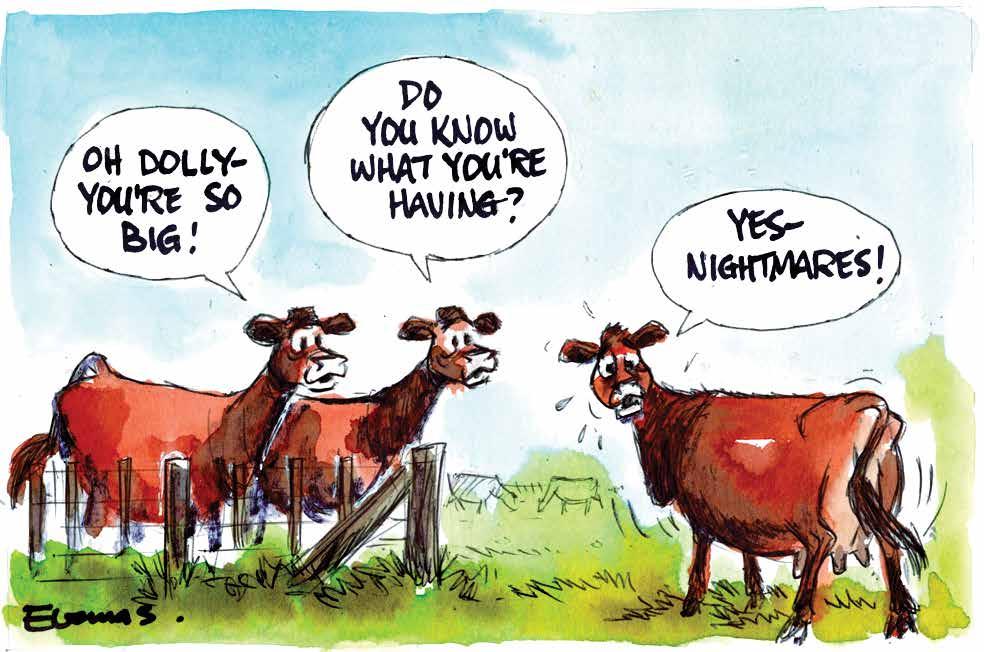
Farmland security
PARANOIA ABOUT foreigners is at an all-time high in the US and attention is now turning to foreign-owned farmland. The Farm Journal reports that the Trump administration is focusing on national security in agriculture, which includes action to “eliminate foreignowned farmland”, especially surrounding U.S. military bases.
The USDA unveiled the National Farm Security Action Plan two weeks ago, aimed at “protecting and securing American farmland from foreign influence”.
The plan is the next pillar of Agriculture Secretary Brooke Rollins’ ‘Make Agriculture Great Again’ initiative that “elevates American agriculture as a key element of our nation’s national security”.
“Too much American land is owned by nationals of adversarial countries, and more than 265,000 acres in the United States are owned by Chinese nationals, much of which is located near critical U.S. military bases,” Rollins told reporters.
Red line on dairy
AS INDIA negotiates to open its borders to more global products, dairy is proving a sticky issue.
As India and the US are preparing to finalise an interim trade deal, India has drawn a line on opening dairy to the US – with “non-veg milk” causing contention. India is asserting that there should be strict certification delineating that imported milk comes from cows that have not been fed animal-based products such as meat or blood. India has termed this as a “non-negotiable red line” because of religious and cultural sensitivities. Milk and ghee are used in religious rituals in India every day.
NZ is also talking to India about a potential trade deal and dairy is again the sticking point.
The Indians are making it clear that there is no question of conceding on dairy. It’s a red line for them.
It’s all about economics
ACCORDING TO media reports, the eye-watering price of butter has prompted Finance Minister Nicola Willis to ask for a ‘please explain’ from her former employer Fonterra.
Dairy is the country’s largest export industry, but recent figures from Stats NZ show domestic butter prices have surged 65% and some people are struggling.
Surely, Willis will understand that global supply problems and high demand for New Zealand’s products are driving local prices higher.
About 95% of New Zealand’s dairy products are exported, which means the international market determines domestic prices.
It is a double-edged sword, where high prices are good for the country’s economy but tough for domestic shoppers.
Synthetic milk WILL SYNTHETIC milk derail NZ’s economy?
According to media reports, professor of economics at Auckland University of Technology, Niven Winchester, believes further development of synthetic milk could seriously disrupt the entire economy.
The scale of disruption though would vary, and there is slow progress at present towards making synthetic milk economic. Even so, dangers lie around the corner, according to Winchester.
“Large-scale production of synthetic dairy products –that decreases the price of New Zealand’s largest export commodity – will have a significant negative impact on this economy,” Winchester says.
This issue has arisen after years of analysis which argued that putting grass into a cow is wasteful because a lot of the output is diverted into growth of the animal. The claims is, putting a feedstock such as sugar into a test tube could produce milk which has less waste and lower environmental side effects.
EDITORIAL
The Government must come clean
FOR MOST farmers and readers, the term Sustainable Finance Taxonomy will make little sense.
But if Federated Farmers and Groundswell are to be believed, then the ‘green’ finance rules being devised by the Government risk doing real harm to rural communities.
The Sustainable Finance Taxonomy is being developed by the Centre for Sustainable Finance and the Ministry for the Environment to provide a consistent framework for defining what is ‘green’ or ‘sustainable’ in financial markets.
Federated Farmers says it would create major risks for New Zealand’s agricultural sector and is urging the Government to halt the process entirely.
One of their core concerns is the lack of practical farming expertise involved in developing the taxonomy – there are no hands-on farmers involved with the Technical Advisory Group. Instead, it’s full of shiny-shoed bankers, sustainability advisors, and forestry lobbyists, according to Feds.
In a letter sent to Ministers and key officials on July 11, Federated Farmers outlined a series of serious concerns with the Sustainable Finance Taxonomy.
Groundswell, which is keeping pressure on the Government to withdraw from the Paris climate change pact, claims under the taxonomy proposal, all farms would be classified as green, amber or red. If a farm is classified red, it is unable to align with Paris 1.5 degree and in the words of the proposal “the only way… is for them to be phased out”.
The Government must come out and explain the NZ Taxonomy proposal.
Some farmers want the Government to disband the taxonomy process entirely, warning it will do more harm than good.
Critics believe that this isn’t a path to sustainable finance. If their claims are right, that it is ideologically driven and practically unworkable, it risks serious harm to rural New Zealand.
Head Office: Lower Ground Floor, 29 Northcroft St, Takapuna, Auckland 0622
Phone 09-307 0399.
Postal Address: PO Box 331100, Takapuna, Auckland 0740
by: Inkwise NZ Ltd Contacts: Editorial: sudeshk@ruralnews.co.nz
: davef@ruralnews.co.nz
: www.ruralnews.co.nz
• Printed by Inkwise • Distributed by Reachmedia
Publisher: Brian Hight Ph 09-307 0399
General Manager: Adam Fricker Ph 021-842 226
Editor: Sudesh Kissun Ph 021-963 177
Machinery Editor: Mark Daniel Ph 021-906 723
markd@ruralnews.co.nz
Reporters: Peter Burke Ph 021-224 2184 peterb@ruralnews.co.nz
Subscriptions: Julie Beech Ph 021-190 3144
Production: Dave Ferguson Ph 027-272 5372
Becky Williams Ph 021-100 4831
Digital Strategist: Jessica Marshall Ph 021 0232 6446
AUCKLAND SALES CONTACT: Stephen Pollard Ph 021-963 166 stephenp@ruralnews.co.nz
Raising the bar for lawmaking
FARMERS AND growers
know the frustration well: Pointless paperwork, slow consents, and confusing red tape that turns simple tasks into complex ones.
As I mentioned in my last column, the rural sector still faces many challenges. While we’re working to clean up existing issues, we also need to prevent future messes—those that arise when regulations are made without proper consultation, clear reasoning, or accountability.
At its core, the Regulatory Standards Bill (RSB) is built on a simple idea: good laws should be made well.
It doesn’t stop governments from legislating on any issue—be it environmental protection, public health, or housing. It simply requires lawmakers to explain themselves. What problem is being solved? What are the costs and benefits? Who gains, who pays, and are we unnecessarily infringing on people’s rights?
Bad regulation doesn’t just cost money, it blocks progress. Developers abandon housing projects due to ballooning compliance costs. Community events vanish under excessive requirements. Even the climbing wall at Sir Edmund Hillary’s old school now bears a “don’t climb” sign—a symbol of regulation gone wrong.
The RSB addresses this by requiring a public Consistency Assessment Statement for every new regulation. This statement must evaluate proposed rules against key principles: Necessity: What problem needs solving?
Clarity: Why this solution?
Personal liberty: Who’s affected and how?
Respect for property: What’s the impact on property owners?
The Bill also creates an independent advisory board—not to veto laws, but to provide expert scrutiny. Parliament still decides, ministers still act, but now they must show their reasoning. No more thumb-sucks or guesstimates.
During my time as
Federated Farmers president, this Bill would have made life easier by spotlighting impractical regulations from Wellington. Even if it didn’t stop bad rules, it would have exposed them before they became law.
Take the winter grazing regulations. Bernadette Hunt’s appearance on breakfast radio helped expose their flaws, leading to changes within days. But they shouldn’t have gotten that far. Where was the necessity assessment? Where was the cost-benefit analysis?
This is exactly what the RSB aims to prevent. By asking basic questions we can catch flawed regulations before they do harm.
I believe the Bill will ensure that when property rights are restricted, there’s proper justification and, where appropriate, compensation.
This is an idea that faces strong opposition from the left, but If property rights matter to you, make your voice heard during the consultation process.
If this all sounds reasonable, you’re not alone. So why the backlash?
Sadly, some activist groups and opposition politicians have responded with misleading claims. Their objections reveal more about political strategy than the Bill itself.
Critics also claim the Bill undermines Māori interests because it doesn’t mention the Treaty. In reality, the Bill operates within New Zealand’s existing legal framework, which already includes Treaty obligations. It doesn’t override settlements, diminish rights, or exclude Māori participation. Nor does it require a Treaty analysis for every regulation; just as the Bill of Rights doesn’t demand one for every rights issue.
This Bill is about building a culture of careful lawmaking. It doesn’t handcuff governments, it demands better preparation. It asks politicians to justify decisions that affect your freedoms, property, and livelihood. In doing so, it strengthens democracy, improves public trust, and raises
the standard of governance.
If critics spent less time crafting conspiracy theories and more time reading the Bill, they’d see it’s not radical, it’s responsible. It informs voters, improves regulation, and discourages poor lawmaking.
Sensible, transparent
lawmaking may not grab headlines, but it helps New Zealanders live without unnecessary bureaucratic interference. The Regulatory Standards Bill is a practical step toward better governance; one that benefits everyone who’s ever been frustrated by regulations that solve imaginary problems
while creating real ones. It’s time to raise the bar for how laws are made in New Zealand. The Regulatory Standards Bill shows us the way forward.
• Andrew Hoggard is the Associate Minister for Agriculture.
@dairy_news facebook.com/dairynews
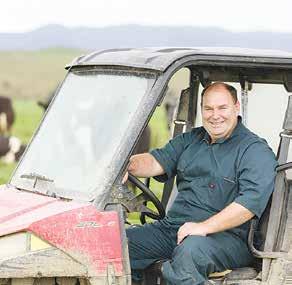
Andrew Hoggard

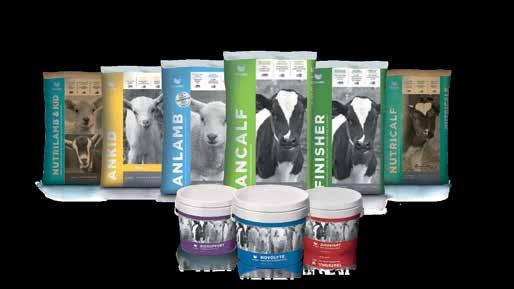
ANDREW HOGGARD
Striking the balance: practical policy for freshwater, farming
AS DECISIONS around freshwater rules edge closer, the message from dairy farmers is clear.
Farmers want – and DairyNZ is strongly advocating for – sensible rules that provide certainty; a focus on ecosystem and human health outcomes rather than just strict nutrient numbers; support for catchment groups and practical mitigations; and policy settings that enable both environmental progress and the future of our dairy sector.
Thank you to everyone who has joined our webinars, spoken with us at catchment meetings, or sent in your views. Your input is important as the first phase of the Government’s freshwater consultation wraps up at the end of July and DairyNZ prepares its submission. Another opportunity will come later this year –likely October – when we see the first draft of the new rules.
What I’m hearing from those I talk with is that without a doubt, dairy remains a valued and valuable sector critical to New Zealand’s future economic suc-

cess – with more enabling policy a shared interest between DairyNZ and the Government.
The Government’s proposals include updates to Te Mana o te Wai, simpler wetland rules, a review of nitrogen limits, and more flexible ways to set freshwater objectives. These changes could reduce red tape, but only if they result in rules that are practical and workable on farm. We support
the consultation process and the goal of improving freshwater policy, but we are advocating for change that reflects on-farm realities and builds confidence for the future.
We support a shift away from rigid numerical limits. Instead, we want to see greater focus on ecosystem and human health outcomes. We support better use of tools like certified and audited Freshwater Farm Plans.
More enabling rules around constructed wetlands is another priority.
The dairy sector is investing heavily in science-backed solutions to reduce its environmental footprint, including nitrogen, phosphorus, and sediment losses.
Proven practices like using plantain, catch crops, good farming practices and stacked mitigations through Low N Systems are already deliv-

ering results, such as the potential for nitrate reductions of up to 60%, with further gains possible with supportive policy. These efforts show the sector’s strong commitment to improving freshwater quality while remaining economically viable.
DairyNZ has spent the past year preparing to provide a workable replacement to the existing policy. Our team has

developed an alternative freshwater framework to support a constructive, science-led response.
We are pushing for four key outcomes: Practical, science-based rules; clearer focus on environmental and human health; farmer-led, catchment-scale solutions that reward good practice; and
a policy package trusted by farmers, communities and markets.
Beyond freshwater, we are involved in the wider RMA reform, where we have concerns. We’ve submitted on both recent Amendment Bills and the Fast-Track Approvals Bill, calling for enduring and enabling policy settings with pragmatic consenting pathways. We are also working with regional councils to ensure the pause on new freshwater plans is used to improve, not shelve, the evidence base for environmental limits.
We know that right now, many of you are doing your best to interpret complex rules while managing the day-to-day realities of farming. And with calving underway or around the corner, it’s all hands on deck.
In the meantime, keep doing the basics well: record nitrogen use, keep stock out of waterways, and implement your Freshwater Farm Plan. Together, we can ensure the next generation of policy supports both a thriving dairy sector and a healthy environment. Thank you for everything you do.
• Tracy Brown is chair of DairyNZ

TRACY BROWN
Proposed changes to freshwater rules could reduce red tape, but only if they result in rules that are practical and workable on farm.
Inset: DairyNZ chair Tracy Brown.


Ospri takes over TB testing
THE MOVE to bring bovine TB testing inhouse at Ospri officially started this month, as a team of 37 skilled and experienced technicians begin work with the disease eradication agency.
Another 10 seasonal field technicians start later in the year.
Ospri took over the TBfree national eradication programme in 2013, and testing was done by AsureQuality.
Ospri general manager disease control, planning and implementation, Simon Andrew, says it now makes sense for Ospri to do the testing, and the transition should be smooth for farmers and the livestock industry.
“Testing in-house is a very important step for Ospri, as an integrated disease control eradication agency,” he says.
“We’re looking forward to carrying out endto-end control of TB.
“We’ve recruited a

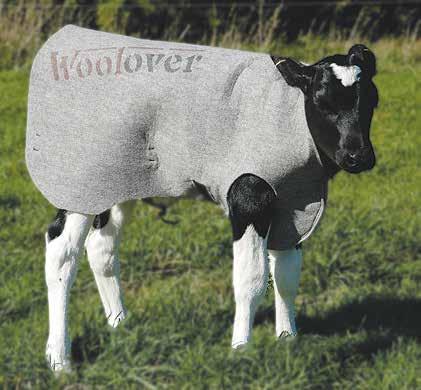
strong team of technicians. The expertise they bring will expand our capability and add value
to our other programmes.
“Testing in-house will bring us closer to farmers, which means we can
be more responsive to what farmers need from testing, and from Ospri.”
In any one year,
a large proportion of the national livestock population is skin tested for TB. The programme undertook about 1.7 million TB tests in the 2023-24 year.
“We know farmers and our funders, MPI and livestock industry bodies Beef+Lamb NZ, DairyNZ and the Deer Industry Association, want to see us make more efficient use of the levies paid for the TBfree programme,” Simon says.
“We are anticipating the cost savings we gain from doing testing in-house will allow us to increase the investment made into possum control, which is the key to achieving TB eradication.”
Farmers don’t need to change what they do. Routine testing will be scheduled when required and to go through normal channels to book a premovement test.
Along with TBfree, Ospri also manages NAIT, the national system for tracing cattle and deer, and MBfree, the national eradication programme for Mycoplasma bovis.
M.BOVIS COMPO SERVICE WRAPS UP
ANOTHER MILESTONE has been reached in the fight against Mycoplasma bovis with the compensation assistance service being wound up after helping more than 1300 farmers.
The DairyNZ Beef + Lamb New Zealand Compensation Assistance Team (DBCAT) was set up in 2018 to help farmers prepare compensation claims during the M. bovis outbreak. During the past seven years, 1370 farmers have used the free service with more than 2310 claims being finalised.
More than $161 million in claims were submitted by the service on behalf of farmers, including $88 million from dairy farmers and $40 million from beef farmers.
It is estimated that the service saved the M. bovis eradication programme more than $10 million by finding smart farm-systems solutions that mitigated the need for a claim.


DairyNZ head of biosecurity Fi Roberts said the service played an important part in supporting farm-
ers through a tough time.
“We know how hard it was for farmers, which is why we wanted to support those affected by getting them through the compensation claim process as quickly as we could. By having a dedicated team, claims could be processed faster and farmers compensated more quickly,” she says.
DairyNZ Chair Tracy Brown says eradicating M. bovis has been one of the most significant biosecurity challenges the sector has ever faced.
“That’s why it was important that the service was operated independently of government so we could provide specific advice and guidance to help farmers through.”
Beef + Lamb New Zealand chair Kate Acland said DBCAT played an important role in helping farmers navigate what was one of the toughest times in their farming careers.
“The service not only made the compensation process more accessible and efficient, but it also
ensured farmers had someone in their corner who understood their operation and their stress.
“We’re proud of the partnership that delivered this support and of the legacy DBCAT leaves in showing how the sector can come together in a time of need.”
DairyNZ partnered with the Ministry for Primary Industries (MPI) and B+LNZ to lead the response phase of the M. bovis eradication programme.
The M. bovis programme is now seven years into a 10-year eradication plan, with currently no active, confirmed properties. The programme transitioned to the M. bovis National Pest Management Plan (NPMP) on 1 January 2025, which Ospri is implementing.
The DBCAT service closed on June 30 with MPI directly handling any new or unresolved claims.
Lessons learned and expertise developed within all the partners continues to inform planning for future incursions, such as Foot and Mouth Disease.
Feeding newborn calves
TO ENSURE optimal growth, health, and wellbeing of calves, feeding strategies should be considered carefully.
Recent research suggests that feeding a higher daily allowance, split into multiple feeds, is better for calves. When choosing between whole milk and milk replacer, both can be economical, but precautions should be taken. Selecting the best system for your farm will help reduce the stress of calf rearing, and ensure your calves get the best start to life.
To ensure optimal growth, health, and wellbeing of calves, feeding strategies should be considered carefully. Recent research suggests that feeding a higher daily allowance, split into multiple feeds, is better for calves. When choosing between whole milk and milk replacer, both can be economical, but precautions should be taken. Selecting the best system for your farm will help reduce the stress of calf rearing, and ensure your calves get the best start to life. How often to feed calves?
Feeding strategies should provide calves with enough energy for growth and play, ensuring they can mount a strong
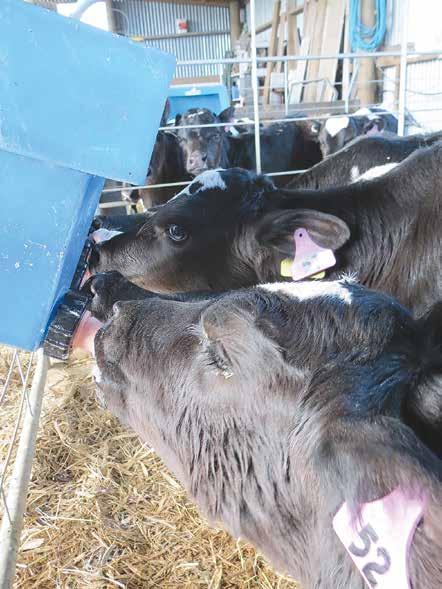
To ensure optimal growth, health, and well-being of calves, feeding strategies should be considered carefully.
immune response, and also meet their behavioural needs.
Recent research shows that feeding calves once a day (OAD) for the first two to four weeks until they can digest solid feed, does not fully provide for their daily nutritional needs. Calves cannot
consume enough milk in one sitting to meet their nutritional needs and will experience hunger. While they can tolerate OAD feeding, it’s not ideal for their welfare.
Feeding milk twice daily for two to four weeks, allows the calf to consume and digest ade-
quate amounts of milk, and therefore energy, to maintain good health and growth. More energy also supports positive behaviour such as running and playing. Ad lib feeding systems also provide these benefits while conserving labour.
Some farms in New
Zealand opt to use automated calf rearing systems, which allow the calf to choose when and how often they feed. This mimics the natural feeding behaviour of a calf on a cow. Properly managed, automated systems have been found to reduce nutritional or non-infectious scours and the need for additional labour.
The National Animal Welfare Advisory Committee (NAWAC) consulted on proposed changes for the Dairy Cattle Code of Welfare from April to June in 2022. In response to recent research, the Committee proposed that calves must be fed twice daily for the first three weeks.
To ensure optimal growth, health, and wellbeing of calves, feeding strategies should be considered carefully. Recent research suggests that feeding a higher daily allowance, split into multiple feeds, is better for calves. When choosing between whole milk and milk replacer, both can be economical, but precautions should be taken. Selecting the best system for your farm will help reduce the stress of calf rearing, and ensure your calves get the best start to life.
• Article- DairyNZ
WHOLE MILK OR MILK REPLACER?
CALVES CAN be reared economically on both whole milk or high quality, reputable milk replacers. In seasonal dairy systems there is often an abundance of surplus milk over spring, and many farms cannot justify the use of milk replacers on economic grounds.
Raw milk is a high-risk pathway for the spread of Mycoplasma Bovis (M. bovis) and certain other infectious diseases. Ensure any milk you sell or purchase is traceable by completing a feed declaration form. There may be other drivers for farmers to use milk replacers, including:
■ Surplus milk is not readily available
■ Milk prices are high
■ Prevent infection from the herd
■ Control of diseases such as M. bovis and Johne’s
■ Automated calf feeding systems
When choosing to use a milk replacer, calves need time to adapt to the new diet. This can be achieved by initially mixing replacer with colostrum/whole milk to let them adjust between the two feeds. Consistency is key to the success of milk replacers. Always read the label and mix according to the directions. Automated calf feeding systems can achieve good results with milk replacers, as the preparation and mixing is consistent. Delivery to the calf and cleaning of the system is often easier and works better with freshly mixed milk powder.
CHOOSING REPLACERS
PROTEIN AND fat are two key components of your feed that should be considered when comparing milk replacers.
Protein
Protein content and source of protein in milk replacers can vary significantly. Calves respond best to dairy-based proteins compared to plant-based proteins. Not all milk replacers will state the protein source, so ensure that you use reputable products that have proven results when feeding young calves.
Fat
Milk replacers commonly provide less fat than whole milk, ranging between 18-22% on a dry matter basis.
Set your farm up for a successful season with support from Farm Source. We’ve got proven products, the latest insights and practical advice to help your farming business thrive.
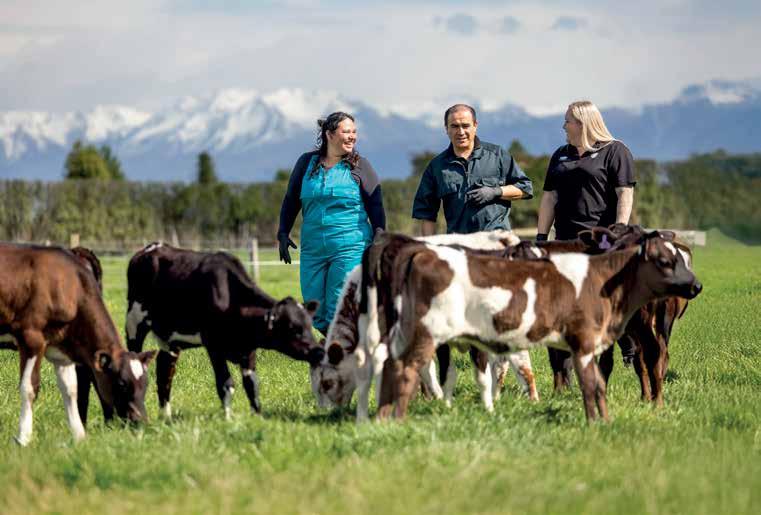
How to make raw milk reliable for calves
FEEDING INFECTED milk is high risk for spreading diseases such as M. bovis.
Milk that has the lowest risk of containing M. bovis bacteria comes in these forms: calf milk replacer powder, acidified milk, or pasteurised milk.
If you’re feeding whole milk, consider the fol-
kill M. bovis if the machine is working correctly and the proper procedures are followed.
■ Adding yoghurt to milk is a less reliable way to reduce the pH, as this process takes more time and is temperature, dependent to get the culture grow-

or vigorous mixing causes coagulation

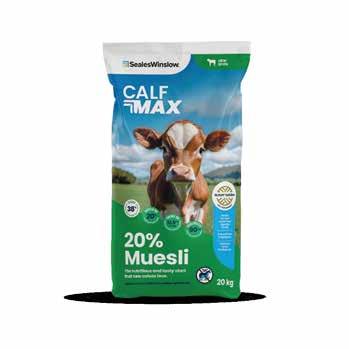
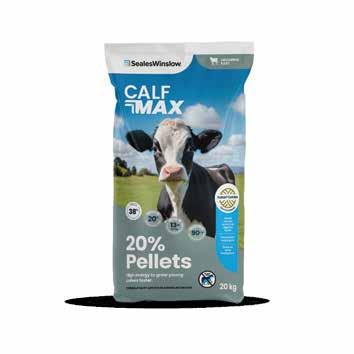
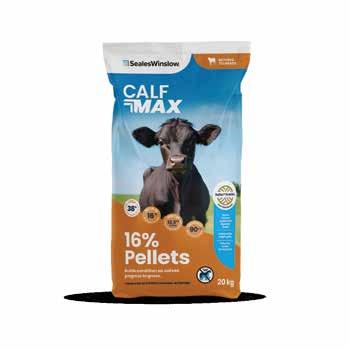
Robotic feeders deliver precise nutrition needed for each calf
JFC AGRI launched its innovative Evolution range of automatic calf feeders, including the state-of-the-art Evolution S4 Automatic unit, to New Zealand in 2024.
The Evo S4 Automatic includes a dual hopper system, each with a 30kg capacity, and dual mixing bowls, allowing it to dispense two different types of calf milk replacers simultaneously, offering the flexibility to ensure each calf receives the precise nutrition needed for optimal growth and


health.
Able to feed up to four calves simultaneously, with individual calf registration via RFID technology, the control unit manages each calf’s feeding schedule. Each animal can be assigned one of seven predefined feed curves tailored to their nutritional needs and rearing objective, ensuring no calf exceeds its allocated feed amount.
The Feeder can reduce the labour hours required for rearing up to 140 calves by as much as 60%, according to the distributor.
Calves are monitored through a traffic light system, with any

• High Flow
• Compact/Robust
• New Pilot Flow Filter
• Side/Bottom Mount
• Detach to Clean

“It’s doing a better job than we could do by hand.”
With the touch of a button on the machine or via the app, Mark can check each animal’s intake and act fast if needed. “It gives us reassurance that everything is okay. If we get a red flag, we look at the volume that calf’s taken and check in on them. It’s so simple.”
The farm rears calves of various ages and sizes. Before the introduction of the Evolution, managing individual intakes was a challenge; bigger calves would drink more, while smaller ones often missed out, leading to slower growth and added stress.
deviations in feed consumption highlighted for immediate inspection. Historical feed performance is recorded and displayed via dynamic charts on a 7-inch touch screen display, online or via the Evolution App. Calves not consuming their full, daily feed allocation are immediately highlighted for further inspection.
Running 121ha of arable land, and a busy contracting business, Mark Sampson decided to reintroduce over 150 calves to his mixed farm. Like so many modern farmers, he quickly ran into the same old limitation –
• For Water Storage Tanks
• Adjustable levels from 50mm-2.5m
• Minimises pump operation
•Available in 20/25/32/50mm
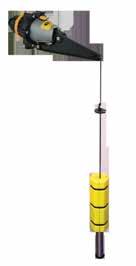
time. He needed a solution that would take the stress out of calf rearing without compromising on care.
“Our big thing that we were suffering with was lack of time. You could hear the calves bawling, so we set out to research automatic milk feeders and eventually came across and purchased the JFC Evolution System. Now, you don’t hear a thing.”
Praising its intelligent design, ease of use, and consistent performance, Mark says the machine always keeps 300ml of milk ready, at the right temperature, mixed to the right consistency.
Now, the Feeder dispenses individualised feeding in 8-hour cycles, ensuring each calf gets what it needs, when it needs it.
“Everything’s more relaxed,” says Mark. “Calves aren’t excited or crying when we arrive, they’re not waiting for humans to feed them. It’s quieter, calmer, and stress-free.”
The unit has saved time, increased calf performance, and the weaning process is now carefully ramped over 7 days, peaking at 10 litres per day, held for 50 days, and then gradually tapered off, resulting in stronger, more consistent animals.
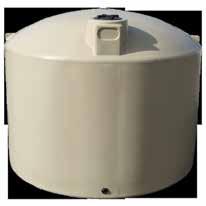

• Stainless steel bracket and Shaft
• Fits plastic and concrete tanks
• Rugged and long lasting

MARK DANIEL markd@ruralnews.co.nz
The Evo S4 Automatic includes a dual hopper system, each with a 30kg capacity.
With the touch of a button on the machine or via the app, a farmer can check each animal’s intake and act fast if needed.
Astronaut A5-Next takes milking to the next level
WITH 2025 marking the 30th anniversary of its first milking robot being installed in Belgium in 1995, Lely says it has taken automated milking to the “next level” with the release of the latest version of the Astronaut Series - the A5-Next.
Utilising a new operating system that allows technicians to perform upgrades at the touch of a button, the new system also lays the foundation for remote servicing and over-the-air software updates.
Having undergone extensive field trials across 71 farms during the development phase, the A5-Next showed reduced alarms, less downtime, and a 10% increase in milkings between alerts, while also diagnosing issues and determining whether a technician is needed.
A redesigned robot arm incorporates the 2+ teat detection system, which combines lasers and cameras to enhance visibility, improve attachment times and reduce stress during heifers’ first milking. It can also provide data on teat health and size, helping Lely to recommend the optimal liners for peak perfor-
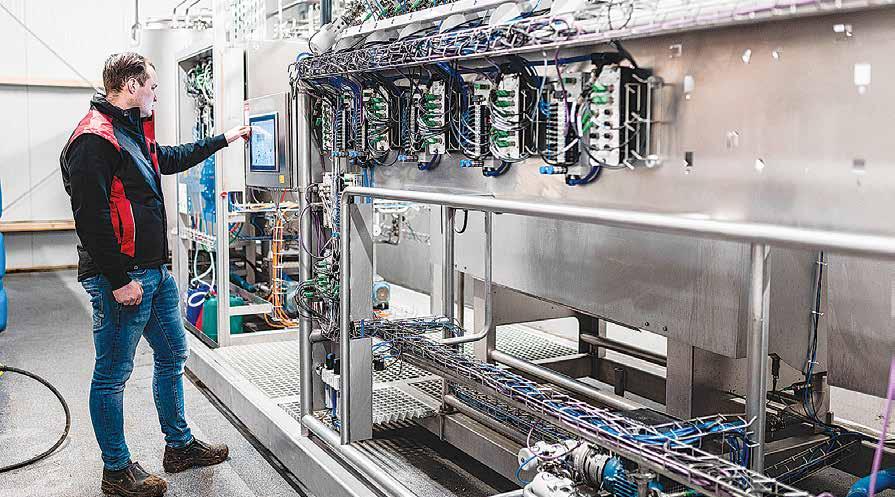
mance. A fully automatic milk filter removes the repetitive task of replacing filter socks by using a back-flush cleaning system, with a stainlesssteel membrane, eliminating the need for filter socks, saving money. One new filter element can service up to four robots.
To make automated milking accessible to more farmers, the A5-Next integrates with electronic ear tag identification to align with cur-
rent regulations. This is particularly relevant in the UK, where EID will become mandatory for newborn calves from 2027.
A “milk for use” feature is said to help improve colostrum quality, incorporating a lowpressure nozzle to reduce foaming and divert colostrum into one of four sealed buckets to protect against flies or contamination.
Smart AI algorithms

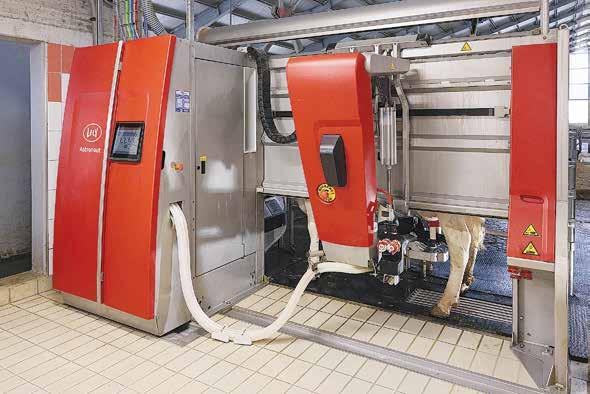
in Horizon generate actionable advice, with backward compatibility offering the possibility to upgrade existing A5 systems with the latest A5-Next features.
Astronaut A5-Next is now commercially available worldwide, with delivery schedules starting from September 2025. In other Lely developments, Astronaut MAX is a combination of units that operate together with the Astronaut system to deliver filtered
and cooled milk over large distances from teat to the bulk tank.
Currently able to support up to 18 robotic units, up to three bulk milk tanks can be connected over distances of up to 400m. Designed for large farms milking 500 to 1100 cows, the system is said to help deliver more milk per labour hour, with a capacity of 60,000 litres per day.
Elsewhere, with an eye towards cyber security, the Lely Hub, is said
to improve digital resilience and data security on-farm, controlling automated server software and security updates, while also facilitating improved remote connections, with secure user access. Managed and monitored by Lely, via a sturdy, wall-mounted control unit, the unit is passively cooled to reduce the impact from dust, while also being configured to connect to an Uninterrupted Power Supply (UPS).
MARK DANIEL markd@ruralnews.co.nz
The Lely Astronaut A5-Next was developed after extensive field trials across 71 farms.
With an eye towards cyber security, the Lely Hub is said to improve digital resilience and data security on-farm.
Astronaut MAX is a combination of units that operate together to deliver filtered and cooled milk over large distances from teat to the bulk tank.
Mowers designed for local conditions

SAMASZ DISTRIBUTOR
FarmShop has introduced the new XDF Series Front Mowers, said to be refined for local conditions and to improve cutting precision and wear resistance.
Featuring a pulltype hitch that allows the mower to contour easily in undulating terrain, rather than a push configuration, that tends to ‘bulldoze’ if incorrectly set, the layout also incorporates up to 22° of lateral tilt, complemented by up to 860mm of vertical travel to cope with the toughest terrain. Hydropneumatic suspension allows for superior contour following, with in-cab pressure control combined with an easyto-read gauge.
The conditioner units are gear-driven, with the ability to run at 700 or 1000 rpm, with simple lever adjustment to change speeds, alongside 8-position conditioning intensity adjustment, allowing fine-tuning in changing conditions.
Available in working widths of 3.0 or 3.5 metres, the cutterbars feature quickchange blades and drive modules, both easily changed in the paddock, to deliver a substantial reduction in downtime for routine maintenance or breakdowns.
The XDF is available with flail-type or roller conditioners, the former fitted with the Samasz’s heavy-duty ‘bear claw’ flails, said to be tailored to be more aggressive for NZ’s harsh conditions, especially the South Island’s irrigated grass and heavy crops.
Standard features include an A-frame hitch, with a new innovative locking system, central greasing for ease of maintenance. Hydraulically operated side guards, offer operator-friendly work start up and moves, while integrated LED lights, marker boards and indicators, ensure safe moves between job sites.
During storage, a patented, support foot mechanism, swings in/ out automatically when required.
MARK DANIEL markd@ruralnews.co.nz @dairy_news facebook.com/dairynews
Visit www.farmshop.co.nz
The XDF is available with flail-type or roller conditioners, tailored to be more aggressive for NZ’s harsh conditions.
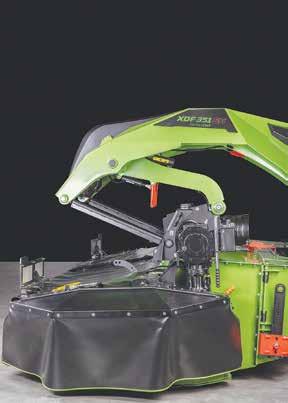


The new XDF Series Front Mowers are refined for local conditions and boosts cutting precision and wear resistance.



